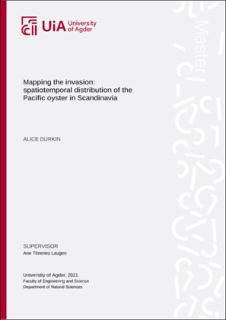| dc.contributor.author | Durkin, Alice | |
| dc.date.accessioned | 2021-09-17T12:59:51Z | |
| dc.date.available | 2021-09-17T12:59:51Z | |
| dc.date.issued | 2021 | |
| dc.identifier.citation | Durkin, A. (2021) Mapping the invasion: spatiotemporal distribution of the Pacific oyster in Scandinavia (Master's thesis). University of Agder, Kristiansand. | en_US |
| dc.identifier.uri | https://hdl.handle.net/11250/2778933 | |
| dc.description | Master's thesis in Coastal ecology (BIO501) | en_US |
| dc.description.abstract | The Pacific oyster (Magallana/Crassostrea gigas) is an invasive species to Scandinavia, originating on the Pacific coasts of Asia. Introduction to Europe of these oysters was a result of farming initiatives, put in place following declines of the native oyster species (Ostrea edulis). The oysters were introduced to Denmark, Sweden, and Norway in farming trials during the 1970s, however Norwegian and Swedish populations have also been a consequence of larval drift. They are not currently commercially farmed in any of the three countries due to the effects that wild populations have on the areas they invade. To map historical and present distribution and identify trends this study assembles all available datasets in each of the three countries from 2005-2020.Temperature and salinity both limit reproductive effort in the oysters, which is why an analysis of those readings has been included in this study. Nine surveys are included; two surveys from Denmark, three from Sweden, and four from Norway. One of the Norwegian surveys was conducted by our team in the Laugen lab in July 2020. Mapping the datasets suggested that the number of oyster populations were increasing in Denmark and showing both increase and decrease in Sweden and Norway, depending on the survey. An increase in temperature and salinity against latitude was found in Denmark, a decrease in average temperature and increase in average salinity in Sweden, and both positive and negative short trends in Norway. Periods with low temperature and/or low salinity can lead to increased adult oyster mortality, as well as limiting reproduction. Overall, the findings suggest that populations are fluctuating in Sweden and Norway but that these fluctuations are unlikely to result in widespread extinction; the connectivity between the three countries will enable larval drift to re-establish populations. Future recommendations are that a standardized protocol for Scandinavian oyster surveying be created, as well as establishing large-scale annual surveys. | en_US |
| dc.language.iso | eng | en_US |
| dc.publisher | University of Agder | en_US |
| dc.rights | Attribution-NonCommercial-NoDerivatives 4.0 Internasjonal | * |
| dc.rights.uri | http://creativecommons.org/licenses/by-nc-nd/4.0/deed.no | * |
| dc.subject | BIO501 | en_US |
| dc.title | Mapping the invasion: spatiotemporal distribution of the Pacific oyster in Scandinavia | en_US |
| dc.type | Master thesis | en_US |
| dc.rights.holder | © 2021 Alice Durkin | en_US |
| dc.subject.nsi | VDP::Matematikk og Naturvitenskap: 400::Zoologiske og botaniske fag: 480::Marinbiologi: 497 | en_US |
| dc.subject.nsi | VDP::Matematikk og Naturvitenskap: 400::Zoologiske og botaniske fag: 480::Zoogeografi: 486 | en_US |
| dc.source.pagenumber | 41 | en_US |

